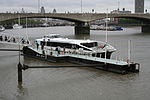Henry Fawcett Memorial
Drinking fountains in the United KingdomGrade II listed buildings in the City of WestminsterLondon stubsMonuments and memorials in LondonOutdoor sculptures in London ... and 2 more
United Kingdom sculpture stubsVictoria Embankment

The Henry Fawcett Memorial is a memorial fountain commemorating Henry Fawcett, installed during 1886 at the Victoria Embankment Gardens in London, United Kingdom. Mary Grant created the portrait relief and George Frampton produced the ornamental elements. Basil Champneys was the architect for the memorial. The Memorial is listed Grade II.
Excerpt from the Wikipedia article Henry Fawcett Memorial (License: CC BY-SA 3.0, Authors, Images).Henry Fawcett Memorial
Victoria Embankment, City of Westminster Covent Garden
Geographical coordinates (GPS) Address External links Nearby Places Show on map
Geographical coordinates (GPS)
| Latitude | Longitude |
|---|---|
| N 51.50907 ° | E -0.12048 ° |
Address
Henry Fawcett Memorial
Victoria Embankment
WC2N 6PA City of Westminster, Covent Garden
England, United Kingdom
Open on Google Maps










